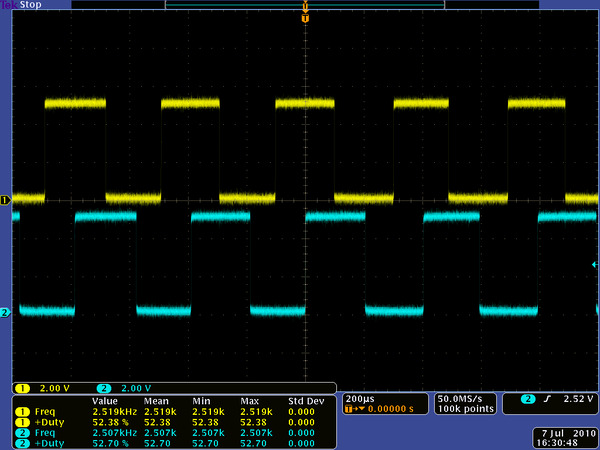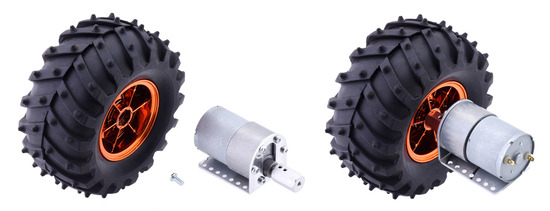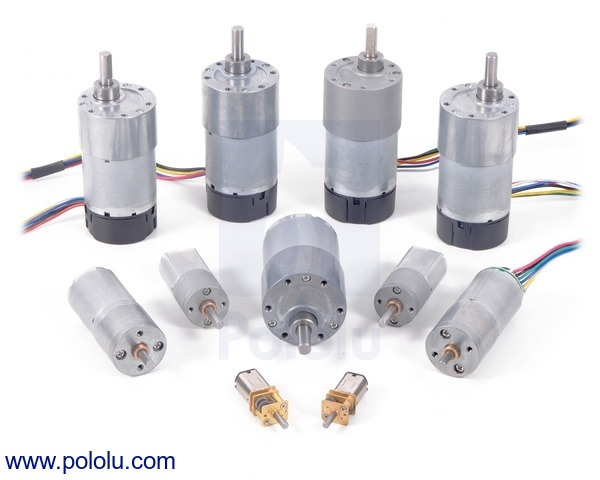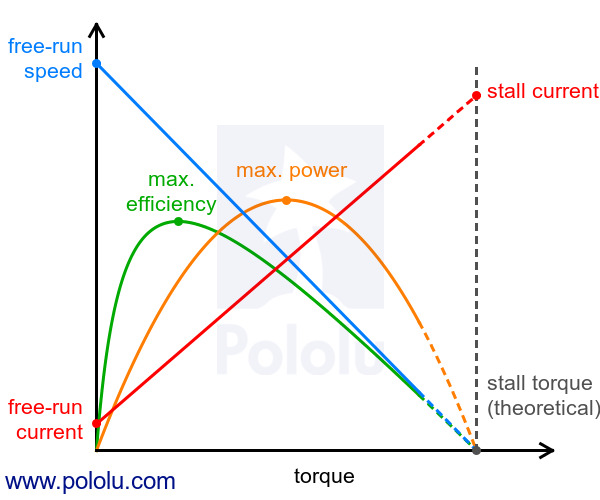This gearmotor is a powerful 12V brushed DC motor with a 102.08:1 metal gearbox and an integrated quadrature encoder that provides a resolution of 64 counts per revolution of the motor shaft, which corresponds to 6533 counts per revolution of the gearbox’s output shaft.
In stock in Australia
Shipping from $7.90
+145 more from our supplier in 7-10 days
Our Code: SKU-005607
Supplier Link: [Pololu MPN:4755]
This powerful brushed DC gearmotor is available in six different gear ratios and features an integrated quadrature encoder with 64 counts per revolution (CPR) of the motor shaft. The motor and encoder portion is available by itself (no gearbox), and versions without the encoder are also available.
| Rated Voltage |
Stall Current |
No-Load Current |
Gear Ratio | No-Load Speed (RPM) |
Extrapolated Stall Torque |
Max Power (W) |
 Without Encoder |
 With Encoder |
|
|---|---|---|---|---|---|---|---|---|---|
| (kg ⋅ cm) | (oz ⋅ in) | ||||||||
| 12 V | 5.5 A | 0.15 A | 1:1 (no gearbox) | 10,000 | 0.5 | 7 | – | – | item #4750 |
| 19:1 | 540 | 8.5 | 120 | 12 | item #4741 | item #4751 | |||
| 30:1 | 330 | 14 | 190 | 12 | item #4742 | item #4752 | |||
| 50:1 | 200 | 21 | 290 | 10 | item #4743 | item #4753 | |||
| 70:1 | 150 | 27 | 380 | 10 | item #4744 | item #4754 | |||
| 100:1 | 100 | 34 | 470 | 8 | item #4745 | item #4755 | |||
| 131:1 | 76 | 45 | 630 | 6 | item #4746 | item #4756 | |||
| 150:1 | 67 | 49 | 680 | 6 | item #2829 | item #2828 | |||
Note: Stalling or overloading gearmotors can greatly decrease their lifetimes and even result in immediate damage. In order to avoid damaging the gearbox, we recommend keeping continuously applied loads under 10 kg-cm (150 oz-in), and the recommended upper limit for instantaneous torque is 25 kg-cm (350 oz-in). Stalls can also result in rapid (potentially on the order of seconds) thermal damage to the motor windings and brushes; a general recommendation for brushed DC motor operation is 25% or less of the stall current.
These motors are intended for use at 12 V, though in general, these kinds of motors can run at voltages above and below the nominal voltage (they can begin rotating at voltages as low as 1 V). Lower voltages might not be practical, and higher voltages could start negatively affecting the life of the motor.
|
|
The black plastic end cap is easily removable if you need to access the encoder or want to slightly reduce the overall gearmotor size, but there is a little bit of base plastic that will remain, as shown in the pictures below:
Exact gear ratio: ``(25×30×28×28×30) / (10×10×12×12×12) ~~ bb(102.083:1)``
This gearmotor is a powerful 12V brushed DC motor with a 102.08:1 metal gearbox and an integrated quadrature encoder that provides a resolution of 64 counts per revolution of the motor shaft, which corresponds to 6533 counts per revolution of the gearbox’s output shaft. These units have a 16 mm-long, 6 mm-diameter D-shaped output shaft. This gearmotor is also available without an encoder.
Key specifications:
| voltage | no-load performance | stall extrapolation |
|---|---|---|
| 12 V | 100 RPM, 150 mA | 34 kg⋅cm (470 oz⋅in), 5.5 A |
This diagram is also available as a downloadable PDF (461k pdf).
Warning: Do not screw too far into the mounting holes as the screws can hit the gears. We recommend screwing no further than 3mm (1/8″) into the screw hole.
The 25D and 37D mm metal gearmotors with encoders have cables that are terminated with a 6-pin, 0.1″-pitch female connector.
A two-channel Hall effect encoder is used to sense the rotation of a magnetic disk on a rear protrusion of the motor shaft. The quadrature encoder provides a resolution of 64 counts per revolution of the motor shaft when counting both edges of both channels. To compute the counts per revolution of the gearbox output, multiply the gear ratio by 64. The motor/encoder has six colour-coded, 8″ (20 cm) leads terminated by a 1×6 female header with a 0.1″ pitch, as shown in the main product picture. This header works with standard 0.1″ male headers and our male jumper and precrimped wires. If this header is not convenient for your application, you can pull the crimped wires out of the header or cut the header off. The following table describes the wire functions:
| Colour | Function |
|---|---|
| Red | motor power (connects to one motor terminal) |
| Black | motor power (connects to the other motor terminal) |
| Green | encoder GND |
| Blue | encoder Vcc (3.5 – 20 V) |
| Yellow | encoder A output |
| White | encoder B output |
The Hall sensor requires an input voltage, Vcc, between 3.5 and 20 V and draws a maximum of 10 mA. The A and B outputs are square waves from 0 V to Vcc approximately 90° out of phase. The frequency of the transitions tells you the speed of the motor, and the order of the transitions tells you the direction. The following oscilloscope capture shows the A and B (yellow and white) encoder outputs using a motor voltage of 12 V and a Hall sensor Vcc of 5 V:
 |
Encoder A and B outputs for 37D mm metal gearmotor with 64 CPR encoder (motor running at 12 V). |
|---|
By counting both the rising and falling edges of both the A and B outputs, it is possible to get 64 counts per revolution of the motor shaft. Using just a single edge of one channel results in 16 counts per revolution of the motor shaft, so the frequency of the A output in the above oscilloscope capture is 16 times the motor rotation frequency.
The face plate has six mounting holes evenly spaced around the outer edge threaded for M3 screws. These mounting holes form a regular hexagon and the centers of neighbouring holes are 15.5 mm apart. We carry two brackets for these gearmotors: a stamped aluminium L-bracket (sold in pairs) and a sturdier, tombstone-style machined aluminium bracket (sold individually):
|
The 6 mm diameter gearbox output shaft works with the Pololu universal aluminium mounting hub for 6mm shafts, which can be used to mount our larger Pololu wheels (80mm- and 90mm-diameter) or custom wheels and mechanisms to the gearmotor’s output shaft as shown in the left picture below. Alternatively, you could use our 6mm scooter wheel adaptor to mount many common scooter, skateboard, and inline skate wheels to the gearmotor’s output shaft as shown in the right picture below:
|
For a general-purpose hex adaptor, consider our 12mm hex wheel adaptor (also available in an extended version), which lets you use these motors with many common hobby RC wheels, including Dagu Wild Thumper Wheels:
  |
12mm Hex Wheel Adaptor for 6mm Shaft connecting a Wild Thumper Wheel to a 37D mm Metal Gearmotor. |
|---|
We have a number of motor drivers and motor controllers that work with these 37D mm metal gearmotors. We generally recommend our High-Power Motor Drivers, which are available in various power levels and versions, including some dual-channel shields for Arduino and dual-channel expansion boards for Raspberry Pi. Additionally, our VNH5019-based motor drivers, which are also available as single and dual carriers, are a good match for these gearmotors.
If you are looking for higher-level control interfaces, such as USB, RC, analogue voltages, I²C, or TTL serial, consider our Simple Motor Controllers, Jrk motor controllers, or RoboClaw motor controllers; these controllers are available in various power levels several of which can handle these 37D mm metal gearmotors (we generally recommend a motor controller that can handle continuous currents above the stall current of your motor).
|
|
|
We have an assortment of Hall effect-based current sensors to choose from for those who need to monitor motor current:
|
|
We offer a wide selection of metal gearmotors that offer different combinations of speed and torque. Our metal gearmotor comparison table can help you find the motor that best meets your project’s requirements.
 |
| Size: | 37D × 72.5L mm1 |
|---|---|
| Weight: | 210 g |
| Shaft diameter: | 6 mm2 |
| Gear ratio: | 102.08:1 |
|---|---|
| No-load speed @ 12V: | 100 rpm |
| No-load current @ 12V: | 0.15 A |
| Stall current @ 12V: | 5.5 A3 |
| Stall torque @ 12V: | 34 kg·cm3 |
| Max output power @ 12V: | 8 W |
| No-load speed @ 6V: | 49 rpm4 |
| No-load current @ 6V: | 0.1 A4 |
| Stall current @ 6V: | 3.0 A5 |
| Stall torque @ 6V: | 21 kg·cm5 |
| Max efficiency @ 12V: | 44 % |
|---|---|
| Speed at max efficiency: | 87 rpm |
| Torque at max efficiency: | 4.2 kg·cm |
| Current at max efficiency: | 0.72 A |
| Output power at max efficiency: | 3.8 W |
| Lead length: | 20 cm6 |
|---|---|
| Encoders?: | Y |
| Encoder resolution: | 64 CPR |
No; the information we have available for this motor can be found on its product page. However, you can approximate various additional motor parameters from the information found in the “Specs” tab.
The electrical resistance of the motor can be approximated by dividing the rated voltage by the stall current (at the rated voltage). The electromotive force constant (Ke) can be approximated by dividing the rated voltage by the free-run speed (at the rated voltage). To approximate the motor torque constant (Kt), you can divide the stall torque by the stall current.
For pretty much any DC motor, the current, speed, power, and efficiency curves as a function of torque will look like those in the graph below (assuming motor voltage and temperature are constant):
 |
The current and speed curves are approximately linear, and the product pages for our motors provide the approximate end points for these lines: (0 torque, no-load current) and (stall torque, stall current) for the red line, and (0 torque, no-load speed) and (stall torque, 0 speed) for the blue line.
The orange output power curve is the product of the speed and the torque, which results in an inverted parabola with its peak at 50% of the stall torque.
The green efficiency curve is the output power divided by the input power, where the input power is current times voltage. The voltage is constant, so you can divide the output power curve by the current line to get the general shape of the efficiency curve, which in turn lets you identify the torque, speed, and current that correspond to max efficiency.
There are many programs out there that you can use to generate these curves. For example, if you have access to MATLAB, you can use this customer-created MATLAB script to generate these motor plots for you from the specifications we provide for each gearmotor.
Note: A good general rule of thumb is to keep the continuous load on a DC motor from exceeding approximately 20% to 30% of the stall torque. Stalling gearmotors can greatly decrease their lifetimes, occasionally resulting in immediate damage to the gearbox or thermal damage to the motor windings or brushes. Do not expect to be able to safely operate a brushed DC gearmotor all the way to stall. The safe operating range will depend on the specifics of the gearmotor itself.